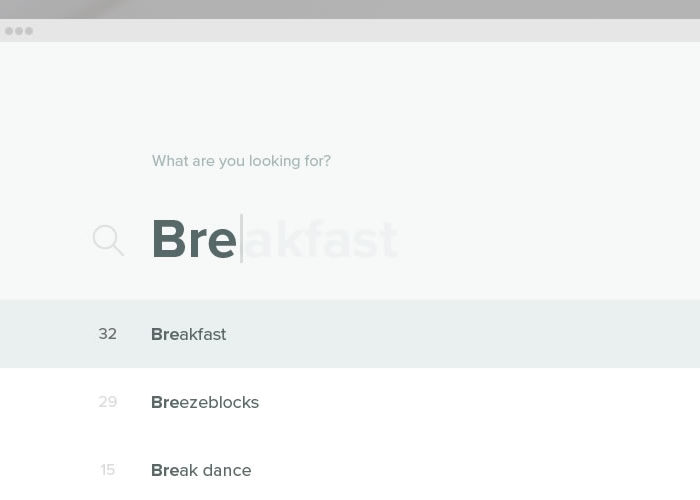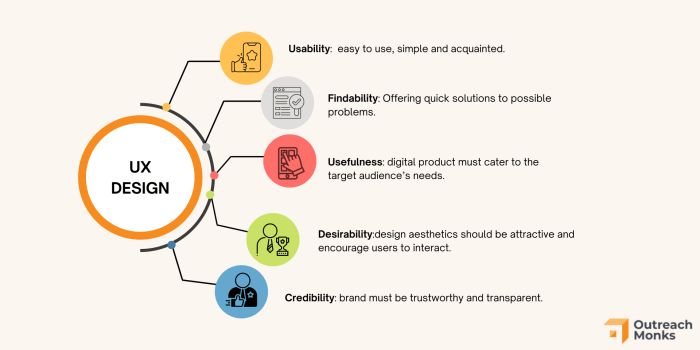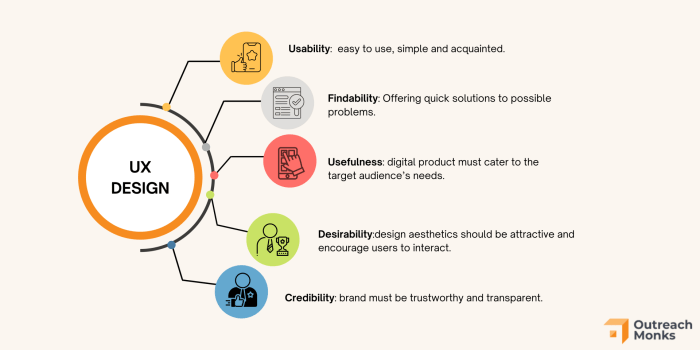Why UX matters to ranking? This exploration delves into the crucial link between user experience (UX) and search engine rankings. A positive UX isn’t just about pleasing users; it’s a powerful tool. A well-designed website, with intuitive navigation, fast loading times, and mobile responsiveness, often translates to higher search engine rankings. Conversely, a poor UX can significantly hinder your site’s visibility.
We’ll dissect the connection between user needs, content strategy, and search results, ultimately revealing how prioritizing UX leads to improved rankings.
This guide examines various UX elements impacting , from website navigation and mobile-friendliness to visual design and usability testing. We’ll explore how aligning your website with user needs, through thoughtful content creation and a seamless user journey, can elevate your search engine rankings. We’ll illustrate these concepts with examples, offering actionable insights for optimizing your website for both users and search engines.
User Experience and Search Engine Optimization () Alignment

User experience (UX) and search engine optimization () are often viewed as separate disciplines, but they are deeply intertwined. A positive user experience is increasingly a crucial factor in search engine ranking algorithms. Understanding this connection allows businesses to craft websites that not only perform well in search results but also engage and satisfy visitors, leading to higher conversion rates.Search engines prioritize websites that offer a seamless and enjoyable experience to users.
This translates into better rankings for websites that demonstrate a strong commitment to UX. A poor UX, on the other hand, can lead to a decline in search engine rankings, as search engines interpret user behavior as an indicator of site quality.
Relationship Between UX and Search Engine Ranking Algorithms
Search engines analyze various user interactions on a website, including time spent on pages, bounce rates, click-through rates, and the number of pages visited. These metrics provide valuable insights into the overall user experience. Websites that excel in these areas generally rank higher in search results, as search engines interpret this data as a sign of a positive user experience.
Positive UX Elements and Influence, Why ux matters to ranking
Positive UX elements directly impact search engine rankings. For instance, a website with a clear and intuitive navigation structure encourages users to explore more pages, reducing bounce rates and increasing engagement. This positive user behavior signals to search engines that the site is valuable and relevant to user queries. Similarly, fast loading times contribute to a positive user experience.
Slow loading speeds can frustrate users, leading to higher bounce rates and lower rankings. Providing mobile-friendliness is another essential UX aspect for a positive user experience. Mobile optimization ensures a consistent and accessible experience across various devices, improving user satisfaction and search engine rankings.
Great UX design isn’t just about making your site pretty; it’s crucial for search engine rankings. A smooth, intuitive user experience keeps visitors engaged, which signals to Google that your site is valuable. Think about how push notifications can help boost engagement—a key factor in ranking, like those discussed in push notifications to boost engagement. Ultimately, positive user experience is a direct path to better search engine visibility.
Negative UX Elements and Impact
Conversely, negative UX elements can negatively impact search engine rankings. A website with a confusing navigation structure or slow loading times will likely lead to high bounce rates. This indicates a negative user experience to search engines, which can result in lower rankings. A lack of mobile responsiveness or inaccessible design choices can further exacerbate the issue, signaling a poor experience across different devices.
Comparison of Strategies and UX Impact
Different strategies can have varying impacts on UX. stuffing, a technique that involves overusing s on a webpage, might improve search engine rankings, but it can significantly detract from the user experience by making the content difficult to read and understand. In contrast, content optimization focusing on providing high-quality, informative content and addressing user needs positively influences UX, leading to higher engagement and potentially better search engine rankings.
Comparison Table of UX Elements and Impact
| UX Element | Description | Impact | Example |
|---|---|---|---|
| Navigation | Intuitive and easy-to-use site structure | Low bounce rate, increased engagement, higher rankings | Clear menus, logical hierarchy, internal linking |
| Page Loading Speed | Fast loading times for all pages | Reduced bounce rate, improved user experience, higher rankings | Optimized images, efficient code, caching |
| Mobile Responsiveness | Website adapts seamlessly to various screen sizes | Improved user experience across devices, higher rankings | Responsive design, mobile-first approach |
| Content Quality | Informative, relevant, and engaging content | Increased time on site, lower bounce rate, higher rankings | Well-researched articles, helpful resources, user-centric approach |
User-Centric Content Strategy and Ranking
Prioritizing user needs in content creation isn’t just good practice; it’s a powerful ranking signal. Understanding what users are looking for and crafting content that directly addresses those needs leads to higher search engine rankings and increased engagement. This approach goes beyond simply stuffing s; it focuses on creating valuable experiences for the user, which search engines reward.Effective content that satisfies user needs not only ranks higher but also fosters loyalty and trust, which translates to long-term success.
This user-centric approach, combined with a robust strategy, builds a solid foundation for sustainable online visibility.
User Needs and Content Types for
Understanding user needs is crucial for creating content that resonates with search intent. Different users have different reasons for searching, and tailoring content to those specific needs is key to improving rankings. This includes considering the user’s goal when searching, whether they’re looking for information, products, services, or a solution to a problem.
| User Need | Content Type | Description | Example |
|---|---|---|---|
| Information seeking | Blog posts, articles, guides | Provides detailed, comprehensive information on a specific topic. | A guide on “how to choose the best running shoes” |
| Product research | Product pages, comparison articles | Offers detailed information about products, including features, specifications, and comparisons. | A comparison of different types of laptops, highlighting their pros and cons. |
| Solution seeking | How-to guides, tutorials, troubleshooting articles | Addresses specific problems or tasks, offering step-by-step instructions or solutions. | A tutorial on “how to fix a leaky faucet” |
| Service finding | Service pages, company profiles | Provides information about specific services, including pricing, availability, and contact details. | A page detailing the services offered by a local plumbing company. |
| Entertainment | News articles, reviews, creative content | Provides engaging content to satisfy the user’s desire for entertainment or leisure. | A review of a new movie, or a humorous blog post. |
Importance of User Intent in Content Creation
User intent is the driving force behind search queries. Understanding what users are looking for when they type a query is crucial for creating content that meets those needs. If users are searching for a specific product, the content should focus on that product; if they are looking for information, the content should provide comprehensive details. The content must align with the user’s goal to maximize engagement and improve rankings.
Content Relevance and User Engagement
Content relevance is directly tied to user engagement with search results. If the content is highly relevant to the user’s search query, they are more likely to engage with it. This engagement, in turn, signals to search engines that the content is valuable and trustworthy, thus improving the ranking. Factors like click-through rates, time on page, and bounce rate all contribute to search engine’s understanding of the user experience with the content.
User experience (UX) is crucial for search engine rankings. A seamless, intuitive website design, for example, leads to more engaged users, which signals to Google that your site is valuable. This, in turn, positively impacts your search engine results. Considering a rebrand? Don’t forget to research your target audience, competitors, and industry trends.
This is key, as understanding your audience’s needs is essential to crafting a compelling UX. You can find helpful tips on key things to research when rebranding your professional services firm5 , ultimately helping to ensure a positive user experience that drives your SEO performance. A solid UX is the cornerstone of good SEO.
Website Navigation and Information Architecture
A well-structured website is more than just a collection of pages; it’s a carefully designed experience. Intuitive navigation is crucial for both users and search engines. Users need to easily find what they’re looking for, and search engines need to understand the site’s structure to effectively crawl and index it. This section delves into the interplay between website navigation, information architecture, and success.Effective navigation isn’t just about making a site look pretty; it’s about making it usable.
Users should be able to find information with minimal effort, and search engines should be able to easily understand the relationship between different pages. This requires a well-thought-out information architecture that considers the user’s needs and the search engine’s requirements.
Intuitive Website Navigation and Search Engine Crawlability
Clear and logical navigation significantly impacts user experience. Users are more likely to explore and engage with a site if they can easily find the information they need. This positive user experience contributes to improved dwell time, reduced bounce rates, and ultimately, better search engine rankings. Similarly, search engines can effectively crawl and index websites with well-defined navigation, which allows them to understand the site’s content and structure.
This clear understanding helps in delivering relevant results to search queries.
Examples of Well-Structured Websites with Good Navigation and Their Success
Several websites exemplify the power of intuitive navigation and its positive impact on . For instance, Amazon’s meticulous categorization and filtering systems allow users to quickly locate products. The clear navigation hierarchy facilitates search engine crawlers in understanding the relationship between different product categories. This structured approach significantly enhances both user experience and search engine optimization. Another example is the website of a leading technology news publication.
A well-organized navigation structure allows users to easily access articles across various technology categories, which is important for both user experience and . The site’s structured layout enables search engines to effectively index the articles and understand the content, making it easier for users to find relevant news.
Impact of Website Speed on User Experience and Search Rankings
Website speed is directly correlated with user experience. Slow loading times can lead to frustration, increased bounce rates, and ultimately, lower search rankings. Users expect websites to load quickly, and search engines consider page speed as a critical ranking factor. Faster websites provide a more positive user experience, leading to higher engagement and better performance. Websites that prioritize load times through optimized images, efficient code, and content delivery networks are more likely to rank higher.
Well-Organized Information Architecture and User Satisfaction
A well-organized information architecture creates a logical structure for the website’s content. This structure facilitates user navigation and helps users find the information they need quickly. A well-organized information architecture not only improves user satisfaction but also helps search engines effectively crawl and index the site’s content. By creating a clear hierarchy and relationship between pages, websites can improve search engine visibility and provide a more intuitive experience for users.
Website Navigation Best Practices
| Navigation Element | Description | UX Benefit | Benefit |
|---|---|---|---|
| Clear Menu Structure | Organized categories and subcategories that logically group content. | Easy navigation, allowing users to quickly find what they need. | Facilitates search engine crawling and understanding of content hierarchy. |
| Descriptive Links | Using clear and concise text for links that accurately reflect the destination page. | Improved understanding of link destination, reducing user confusion. | Provides search engines with context about the linked page. |
| Internal Linking Strategy | Connecting relevant pages within the website using appropriate anchor text. | Enhances user exploration and discovery of related content. | Helps search engines understand the relationships between pages and improves site authority. |
| Breadcrumbs | Displaying the path users have taken to reach a specific page. | Provides context and helps users retrace their steps. | Assists search engines in understanding the site structure and content hierarchy. |
Mobile-Friendliness and Accessibility
A seamless user experience transcends desktop screens; it extends to the ever-growing realm of mobile devices. Mobile-friendliness is no longer a desirable feature but a fundamental necessity for modern websites. Users expect websites to adapt effortlessly to their devices, whether it’s a smartphone, tablet, or foldable phone. This adaptability directly impacts both user engagement and search engine ranking.Today’s users often access websites primarily through their mobile devices.
Websites that aren’t optimized for mobile devices create a frustrating user experience, leading to high bounce rates and lost conversions. Conversely, mobile-optimized sites foster engagement, encourage longer visits, and ultimately drive better business outcomes. Search engines, recognizing this shift in user behavior, prioritize mobile-friendly websites in their ranking algorithms. This prioritization ensures that users find relevant and easily navigable content, regardless of the device they use.
Mobile-Friendliness for User Experience and Search Ranking
Mobile-friendly websites are crucial for user experience. They provide a positive and intuitive browsing experience across various screen sizes. Features like responsive design, touch-friendly interfaces, and optimized loading times contribute to a smooth and efficient interaction. This translates into higher user satisfaction and a reduced likelihood of users abandoning the site. Search engines reward this user-centric approach, as it aligns with their goal of delivering relevant and accessible content to users.
Examples of Mobile-Friendly Websites
Many websites demonstrate the power of mobile optimization. For example, [Insert website example 1, a renowned e-commerce site], known for its extensive product catalogs, has a remarkably smooth mobile experience. The site’s navigation is intuitive, product images are clear, and checkout is streamlined, all factors contributing to high user engagement. Similarly, [Insert website example 2, a news publication], provides a concise and well-organized mobile view, making it easy for users to consume news on the go.
These examples showcase how effective mobile optimization can significantly improve user experience and contribute to higher search rankings.
Website Accessibility for Users with Disabilities
Website accessibility is a critical aspect of user experience, ensuring that individuals with disabilities can access and interact with content. This includes considerations for users with visual impairments, auditory impairments, motor impairments, and cognitive disabilities. Features like alternative text for images, keyboard navigation, and proper color contrast are fundamental to accessibility. Search engines value websites that prioritize accessibility, recognizing the broader audience they serve and reflecting their commitment to inclusivity.
Incorporating Accessibility Features to Improve Overall User Experience
Incorporating accessibility features doesn’t just benefit users with disabilities; it enhances the overall user experience for everyone. For instance, alternative text for images not only helps screen reader users but also improves search engine optimization by providing context to the image. Similarly, keyboard navigation ensures that users without a mouse can still interact with the website effectively. These features create a more inclusive and user-friendly environment for all visitors.
Importance of Mobile Optimization for UX and
| Mobile Feature | Description | UX Impact | Impact |
|---|---|---|---|
| Responsive Design | Adapts the website’s layout and content to different screen sizes. | Improved usability and navigation on various devices. | Higher search rankings due to mobile-friendliness signals. |
| Fast Loading Speed | Ensures quick loading times on mobile devices. | Reduces bounce rates and improves user satisfaction. | Improved search rankings, as speed is a crucial ranking factor. |
| Touch-Friendly Interface | Provides intuitive navigation and interactions via touch. | Increased user engagement and reduced frustration. | Enhanced user experience, contributing to better search rankings. |
| Clear Visual Hierarchy | Organizes content in a clear and easy-to-understand manner. | Facilitates quick information retrieval and improved user comprehension. | Improved content readability, positively impacting search engine rankings. |
Usability Testing and Data Analysis
Uncovering user pain points and optimizing websites for both users and search engines is crucial for success in today’s digital landscape. Usability testing, combined with data analysis, provides valuable insights into how users interact with a website, revealing areas needing improvement that directly impact performance. This data-driven approach allows for iterative refinements that enhance user experience and, consequently, search engine rankings.
The Role of Usability Testing in Identifying UX Issues and Implications
Usability testing is an iterative process that involves observing real users interacting with a website or application. This process can reveal subtle usability issues that might not be apparent through simply reviewing the design. These issues can range from confusing navigation to unclear calls to action, impacting user satisfaction and ultimately, the website’s search engine ranking. By understanding user behavior, testers can identify areas where users struggle to find the information they need, leading to improved website architecture and content organization.
Furthermore, usability testing provides valuable insights into the website’s strengths and weaknesses, enabling strategic improvements in content and design, which directly translates into enhanced performance.
Examples of Usability Testing to Optimize Websites for Users and Search Engines
Usability testing can be employed to address various aspects of website design and functionality. For instance, testing the effectiveness of different calls-to-action can lead to a more user-friendly experience and higher conversion rates. Analyzing how users navigate the site through various pages can reveal bottlenecks or areas of confusion in the information architecture. By addressing these usability issues, websites can improve user engagement, leading to better rankings.
A significant example of this would be optimizing a website’s search functionality. If users find it difficult to locate relevant content through the site’s search bar, usability testing can identify the cause of this problem, such as unclear search parameters or insufficient indexing of the website’s content. Addressing these issues through testing can lead to a more robust search experience, positively impacting .
Using User Analytics Data to Identify UX Improvement and Optimization Areas
User analytics tools provide a wealth of data on how users interact with a website. This data includes metrics like bounce rate, time on site, pages per visit, and conversion rates. Analyzing this data can pinpoint areas where users are leaving the site prematurely or struggling to complete desired actions. For instance, a high bounce rate from a specific landing page might indicate a problem with the page’s content, design, or layout.
By combining this with usability testing data, the website owner can identify specific issues and implement targeted solutions, improving user experience and .
Correlation Between User Behavior Data and Search Engine Ranking
A strong correlation exists between user behavior and search engine rankings. Search engines like Google use various signals, including user engagement metrics, to evaluate a website’s relevance and authority. If users spend significant time on a page, interact with its content, and return to the site, this signals to search engines that the content is valuable and relevant.
User experience (UX) is crucial for search engine rankings. A smooth, intuitive website experience keeps visitors engaged and coming back, which positively impacts SEO. Understanding the key differences between Universal Analytics (UA) and Google Analytics 4 (GA4) metrics is essential for accurately assessing this user engagement. For example, comparing bounce rates and session durations in GA4 versus UA can reveal vital insights about user flow and identify pain points.
This knowledge helps you optimize your UX, leading to higher rankings. This article dives deeper into the specific nuances you should consider. Ultimately, focusing on a great UX will help you improve your website’s position in search results.
Conversely, high bounce rates, short session durations, and low engagement indicate issues that need to be addressed. User behavior data, therefore, acts as a crucial indicator of the effectiveness of UX efforts and the alignment with search engine ranking factors. This is because users are more likely to stay on sites that are easy to navigate and provide the information they need.
Usability Testing Methods and Implications
| Testing Method | Description | UX Insights | Insights |
|---|---|---|---|
| A/B Testing | Comparing two versions of a webpage to see which performs better. | Identifies elements that enhance user engagement and task completion. | Indicates which design or content strategy yields better user interaction, impacting click-through rates and search rankings. |
| Card Sorting | Users categorize website content into groups. | Reveals user mental models of website organization. | Improves site navigation and information architecture, potentially leading to improved user experience and higher rankings. |
| Eye Tracking | Records eye movements to understand how users scan the page. | Identifies elements that draw user attention, highlighting areas of high interest or confusion. | Optimizes content placement, improving the visual hierarchy and providing a clear path to key information, thus positively influencing search engine ranking. |
| Usability Testing with Surveys | Users answer questions about their experience and expectations. | Gathers feedback about the user experience and satisfaction. | Provides insights into user needs and expectations, helping to create content and design that better aligns with search engine ranking signals. |
Visual Design and User Engagement: Why Ux Matters To Ranking

Visual design is more than just aesthetics; it’s a powerful tool for shaping user experience and influencing search engine rankings. A well-designed website not only captivates users but also communicates information effectively, encouraging interaction and ultimately, positive search engine results. This section delves into the crucial role of visual design in boosting user engagement and search engine visibility.Effective visual design goes beyond simply making a website look pretty.
It’s about creating a harmonious blend of visual elements—colors, typography, imagery, and layout—that enhances user understanding and fosters a positive interaction. This approach translates into improved user experience and ultimately, a better search engine ranking.
Visual Hierarchy and User Engagement
Visual hierarchy establishes a clear order of importance for visual elements on a webpage. This is achieved through varying font sizes, weights, colors, and spacing. By strategically using visual cues, designers guide the user’s eye to key information, enhancing comprehension and engagement. A strong visual hierarchy improves the user’s ability to quickly scan and absorb crucial content, leading to increased user satisfaction and potentially higher search engine rankings.
Examples of Effective Visual Design
Numerous websites excel in visual design, demonstrating its positive impact on user engagement and search engine rankings. For instance, websites like Airbnb, with its captivating imagery and intuitive layout, showcase how compelling visuals can draw users in. Similarly, the clean and modern design of a site like Shopify effectively communicates its offerings and guides users through the site.
These sites prioritize user experience, making it easier for visitors to find what they need. This focus on user-friendliness often leads to higher search rankings as search engines favor sites that provide a positive user experience.
Impact of Visual Design on UX and
The table below illustrates the impact of various visual design elements on user experience and search engine optimization.
| Design Element | Description | UX Impact | Impact |
|---|---|---|---|
| Color Palette | The selection of colors used throughout the website. | Can evoke emotions, create a brand identity, and improve readability. | Consistent color schemes can improve brand recognition, potentially leading to higher click-through rates from search results. |
| Typography | The choice of fonts and their usage. | Impacts readability, brand personality, and overall aesthetic. | Clear and legible typography improves the user experience, which search engines often correlate with higher rankings. |
| Imagery | The use of visuals like photos, illustrations, and icons. | Enhances engagement, conveys information effectively, and breaks up text blocks. | High-quality, relevant imagery can improve user engagement, potentially leading to longer session durations and higher search rankings. |
| Layout and Structure | The arrangement of elements on a page. | Impacts navigation, information comprehension, and overall visual appeal. | A well-structured layout can improve site crawlability and indexability by search engines. |
Last Word
In conclusion, a strong user experience is no longer a luxury but a necessity for high search engine rankings. By prioritizing user needs and crafting a website that’s intuitive, accessible, and engaging, you’re investing in a strategy that directly impacts your visibility and ultimately drives organic traffic. Implementing the UX principles Artikeld here will not only enhance user satisfaction but also boost your website’s position in search results.
Remember, a happy user is a valuable user, and a valuable user is a key to success in the digital landscape.





